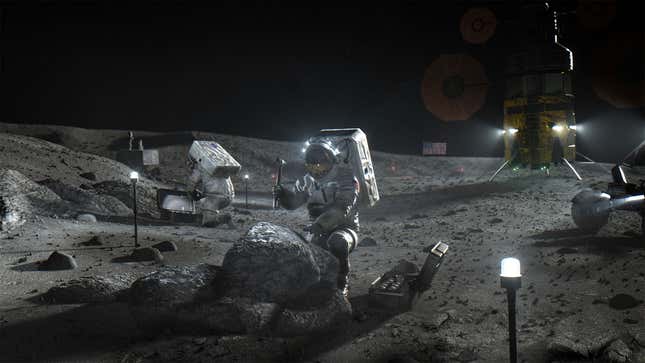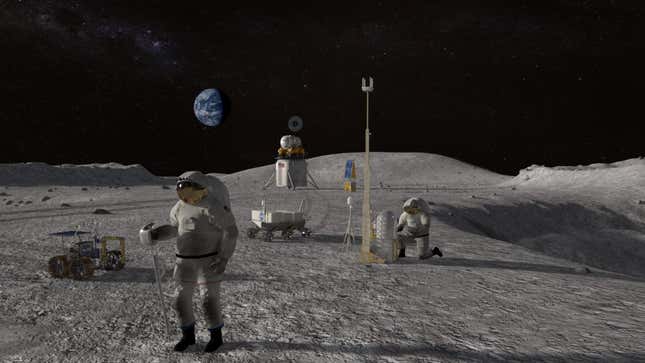
NASA has released its science priorities for the first crewed Artemis lunar landing, scheduled for 2024. Prior to planting their boots on the lunar regolith, however, the next man and woman to visit the Moon will have to go back to school, as mission planners prepare their tools for the upcoming mission.
“The Moon holds vast scientific potential and astronauts are going to help us enable that science,” Thomas Zurbuchen, associate administrator for NASA’s Science Mission Directorate, explained in a NASA statement yesterday. “This report helps outline a path forward toward the compelling science we can now contemplate doing on the lunar surface in conjunction with human explorers.”
Indeed, the 2024 Artemis III mission will involve a phrase that’s near and dear to the hearts of scientists: in situ. In this context, the Latin phrase means “on site,” which, when you’re talking about humans working on the surface of the Moon, is a very rare and special occurrence. That astronauts will be conducting lunar science in situ in just a few years is thus a big deal, and NASA is preparing accordingly.
To that end, the space agency has released a 188-page report on the matter, detailing its scientific priorities for the Artemis III mission. Among the many goals listed, NASA wants to ensure that the two astronauts selected for the mission will have the requisite scientific training, a diverse range of sampling tools and capabilities, on-demand access to experts on the ground, and the ability to safely store a variety of sample materials for the return trip back to Earth. What’s more, NASA wants the team to return more than twice the typical amount of surface material collected during the Apollo missions.

Ultimately, NASA hopes these investigations “will help scientists better understand fundamental planetary processes that operate across the solar system and beyond.” Work done during the Artemis III mission should further the space agency’s plans to build a base on the Moon and also set the stage for a crewed mission to Mars.
Oh, in case you’re wondering about Artemis I and Artemis II, the first mission will involve the inaugural launch of NASA’s SLS rocket, scheduled for late 2021, while the second mission, slated for 2023, will see a crew launched to Earth orbit (but not to the Moon). So yeah, Artemis III will be a pretty big leap. Both Apollo 8 and Apollo 10, in what were called “dress rehearsal” missions, orbited the Moon prior to the famous Apollo 11 crewed landing in 1969.
In the new report, NASA outlined seven scientific objectives for Artemis III. These include a better understanding of planetary processes and the “character and origin of lunar polar volatiles,” such as water-ice. The mission should provide insights into the Moon’s impact history and allow for observations of the “universe and the local space environment from a unique location.” NASA is also hoping to uncover a record of the Sun’s history and the astronomical environment in general. The astronauts will conduct some experiments in the lunar environment, and the mission as a whole should better inform planners about the potential risks faced by humans in space. NASA’s Science Definition Team came up with these objectives in consultation with the scientific community and by referencing guiding documents prepared over past decade.
All of this will have to be accomplished in the 6.5 days allotted for the Artemis III mission. The new report gives us a good idea of what the astronauts will be doing, and it now gives mission planners something to work with as they forge ahead. For example, engineers working on xEMU, the lunar spacesuit, now have a better sense of what the astronauts will need for the scientific aspect of the mission, which wasn’t entirely clear prior to the report.
And indeed, the new report is chock-full of recommendations.
Like the Apollo crews, Artemis astronauts will be expected to attend courses in geology and planetary sciences, which will involve time in the classroom and investigations in the field. The report asks that a real-time data and video link be provided to the astronauts while working on the Moon, connecting them to science experts on Earth. The delay won’t be a problem, as it takes radio signals around 2.4 to 2.7 seconds to make a round trip. Contrast that with Mars, for example, in which a back-and-forth with Earth would take between 10 to 40 minutes, depending on the position of the two planets.

The report asks for lighter and more versatile scientific instruments capable of collecting multiple lines of evidence (single-use devices need not apply). The astronauts should collect a diverse set of sample material and use lightweight, double-sealed vacuum containers for the return journey back to Earth. The crew should also be equipped with cryogenic containers to store volatiles like water-ice. In total, NASA is hoping to acquire 183 pounds (83 kilograms) of lunar material, which is “slightly more than the 64 kg [141 pound] average sample return mass from the Apollo missions,” according to the report.
To facilitate this work, the report recommends that tools, equipment, and scientific resources be delivered to the Artemis III landing site near the Lunar South Pole prior to the arrival of the astronauts. This could include a rover, which the authors say would vastly improve the landing crew’s mobility and in turn improve their ability to collect a diverse array of samples. Good maps would also help, according to the report.
This all sounds pretty amazing and exciting. A launch in 2024, however, is no sure thing, given how much work there’s left to do and the uncertainty posed by the incoming Biden administration. The president-elect has been tight-lipped about his pending NASA policy, and it’s not immediately clear if a mission to the Moon will be among his highest priorities.